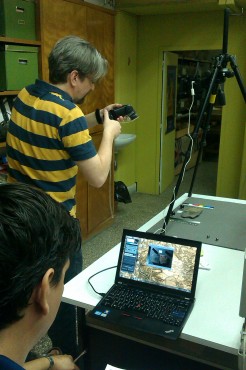RTI of Linear B tablets in the National Archaeological Museum, Athens, Greece
By Dimitri Nakassis
 For four weeks this summer, a team of researchers began RTI work and 3D structured light scanning on clay administrative tablets from the “Palace of Nestor” at Pylos, now housed in the National Archaeological Museum in Athens, Greece. Co-directed by Kevin Pluta (formerly College of Charleston, now at the Program in Aegean Scripts and Prehistory, at the University of Texas at Austin) and Dimitri Nakassis (University of Toronto), the team also included Jami Baxley and James Newhard (both College of Charleston) and Benjamin Rennison (Clemson University). Hembo Pagi (ACRG, University of Southampton) worked with the team for several days to train us in RTI. This summer some 300 tablets were photographed and scanned, out of some 1000 tablets and other inscribed clay documents (principally labels and sealings); we plan to continue imaging the remaining tablets and documents in the summer of 2014.
For four weeks this summer, a team of researchers began RTI work and 3D structured light scanning on clay administrative tablets from the “Palace of Nestor” at Pylos, now housed in the National Archaeological Museum in Athens, Greece. Co-directed by Kevin Pluta (formerly College of Charleston, now at the Program in Aegean Scripts and Prehistory, at the University of Texas at Austin) and Dimitri Nakassis (University of Toronto), the team also included Jami Baxley and James Newhard (both College of Charleston) and Benjamin Rennison (Clemson University). Hembo Pagi (ACRG, University of Southampton) worked with the team for several days to train us in RTI. This summer some 300 tablets were photographed and scanned, out of some 1000 tablets and other inscribed clay documents (principally labels and sealings); we plan to continue imaging the remaining tablets and documents in the summer of 2014.
The goal of the project is to image all of the tablets from the “Palace of Nestor” using RTI and structured light scanning to provide researchers with imaging that approaches autopsy. This will put the primary data in the hands of researchers. This is a big leap forward, since Mycenaean scholars typically work with transcriptions of the tablets; only a few line drawings and conventional photographs of the tablets from Pylos have been published. But even line drawings and conventional photographs, useful as they are, cannot capture enough information for researchers to work with the primary data, so that, for example, they can draw their own conclusions about the text and challenge editorial readings. We also hope that our work will lessen the need for researchers to handle the tablets, thereby promoting their conservation. Now that the handful of Linear B tablets at the Ashmolean Museum have been imaged with RTI through a joint project with the University of Southampton (RTISAD) , it is possible that a more complete digital library of Linear B may become available to scholars in the future.
- More about the project from the American School of Classical Studies at Athens website
